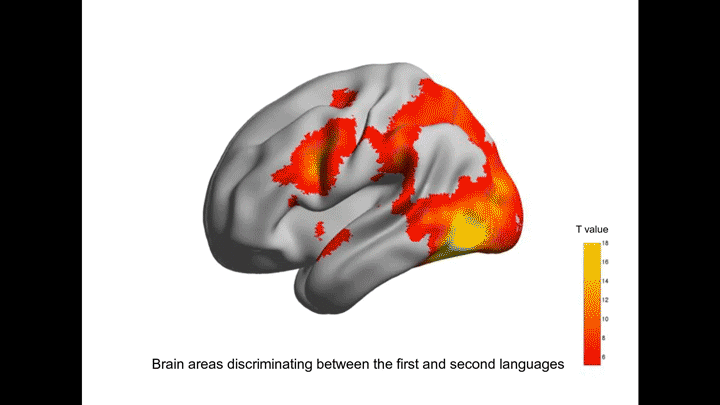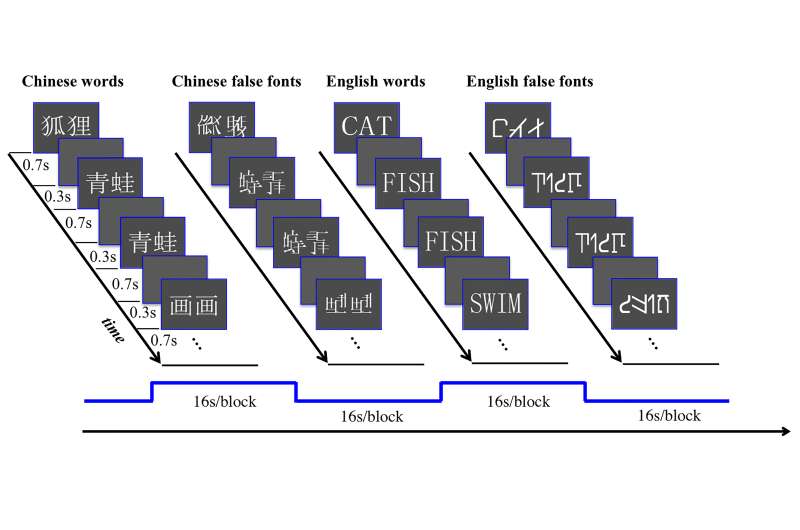July 13, 2017 report
Using fMRI and multivoxel pattern analysis reveals independent brain activation patterns in bilingual people

(Medical Xpress)—A team of researchers from China and the U.S. has found independent brain activation patterns in bilingual people when they switch between languages. In their paper published on the open access site Science Advances, the group explains how they used a two-pronged approach to learn more about how the brain allows people to speak in more than one language.
Scientists have long been intrigued by the brain's ability to learn more than one language—perhaps equally intriguing is the ability of the brain to instantly switch between languages. Prior research has suggested that the brain allows for multiple language abilities simply by using a single processing system for both. If true, this would suggest, perhaps, that the brain simply sees two languages as one big language. But that line of reasoning might be wrong, as the researchers with this new effort have found evidence that suggests the brain uses the same parts of the brain for different languages but develops different neural circuitry for each.
To come to this conclusion, the researchers used a two-pronged approach to studying what goes on as people use two different languages. They enlisted the assistance of 14 bilingual (English/Mandarin Chinese) people and asked them to engage in word processing tasks while undergoing fMRI brain scans. The tasks involved watching as two words were shown to them, one in Mandarin, the other English, and pressing a key when the words had the same meaning. They were also shown words in "false fonts," in which strokes were scrambled. In addition to noting which parts of the brain lit up during various activities, the researchers also used multivoxel pattern analysis on the scans—a technique that involves statistics applied to more than one outcome at a time using machine learning.
By combining the two study methods, the researchers observed overlapping parts of the brain used to handle the two languages—but in the parts that were shared, there were different neural networks for each. This, the team suggests, indicates that the brain was using the same regions for language processing, but had different neural networks in each for processing the two very different languages.

More information: Min Xu et al. Distinct distributed patterns of neural activity are associated with two languages in the bilingual brain, Science Advances (2017). DOI: 10.1126/sciadv.1603309
Abstract
A large body of previous neuroimaging studies suggests that multiple languages are processed and organized in a single neuroanatomical system in the bilingual brain, although differential activation may be seen in some studies because of different proficiency levels and/or age of acquisition of the two languages. However, one important possibility is that the two languages may involve interleaved but functionally independent neural populations within a given cortical region, and thus, distinct patterns of neural computations may be pivotal for the processing of the two languages. Using functional magnetic resonance imaging (fMRI) and multivariate pattern analyses, we tested this possibility in Chinese-English bilinguals when they performed an implicit reading task. We found a broad network of regions wherein the two languages evoked different patterns of activity, with only partially overlapping patterns of voxels in a given region. These regions, including the middle occipital cortices, fusiform gyri, and lateral temporal, temporoparietal, and prefrontal cortices, are associated with multiple aspects of language processing. The results suggest the functional independence of neural computations underlying the representations of different languages in bilinguals.
© 2017 Medical Xpress















